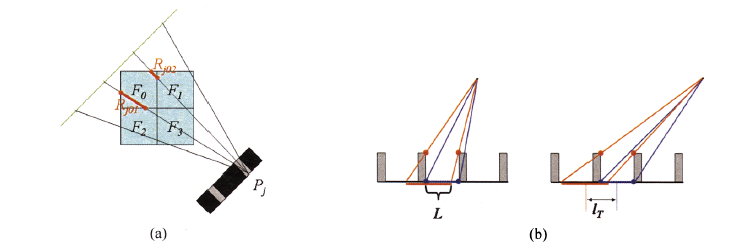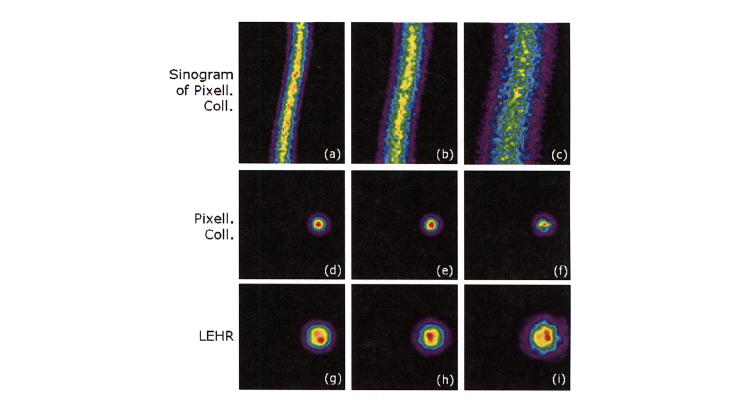ONGOING PROJECTS
- Development of Remote Radiation Detection Imaging System Mounted on a Drone
- High Resolution SPECT using Variable Pinhole Collimator
- Positioning Algorithm for CZT Virtual Frisch-grid Detector
- Multi-purpose Super-resolution Gamma Detector
- Multi-pinhole SPECT
- Low Profile Light Guide using Diffusion Film
- Advanced Reconstruction for Radiation imaging (ARRA)
COMPLETED PROJECTS
- Reconstruction of Dose Distribution in In-beam PET for Carbon Theraphy
- Image Registration for Breast Cancer Study
- High Energy Collimator Design for I-131
- Plasma-Display-Panel based X-ray Detector (PXD)
- CCD based Gamma Camera
- Abdomen Registration for PET/CT and MR images
- Performance Optimization by Patient Dose Analysis and Image Quality Assessment in CT Fluoroscopy
- Cone-beam based system matrix for a pixelated SPECT detector
- Development of Time-of-Flight Method for Improvement of Signal-to-Noise Ratio
Registered Collimation for pixelated SPECT Detectors
Introduction
Many research groups and companies have been developing Cadmium Zinc Telluride (CZT) and/or Cadmium Telluride (CdTe) based pixelated SPECT detectors. Major advantages of those detectors include: good energy resolution, compactness and direct conversion capability of gamma ray to electrons. However, charge-sharing among adjacent pixels is one of the major drawbacks of such detectors. In addition, the charge-sharing effect is increased as the height of the CZT pixel increase. Consequently, it is difficult to increase the sensitivity of CZT based detectors by increasing its height.
In this study, we designed a high sensitive registered collimator. The pitch of collimator hole was designed to align with the CZT pixel. In addition, the collimator septa were made thick enough (~1 mm) to provide better gamma ray stopping power and to physically prevent gamma ray interactions between CZT pixel boundaries as well. The major design consideration was having an ultra-high sensitive collimator by wide opening holes and short septa height without scarifying system resolution. Thus the goal of this study is two folds: 1) to determine the optimal parameters of the collimator which can increase sensitivity and decrease the charge sharing effect, and 2) to develop system matrix for iterative image reconstruction that can adequately model the proposed collimation scheme to achieve high resolution recovery in spite of using wider collimation holes.
Materials and Methods
Sensitivity target of the registered collimator was set to ten times as high as that of low energy high resolution (LEHR) collimator while preserving the same. The desirable specifications of the registered collimator were analytically calculated first. Then they were evaluated with simulation data after the system model was constructed based on geometrical response of the system.
A. Specifications of registered collimator
Fig. 1 illustrates the LEHR collimator and the registered collimator to be investigated in this study. The thickness, height and pitch of the septa were set to 0.3087 mm, 24 mm and 1.11 mm for the LEHR collimator, respectively. For the registered collimator, only the pitch was initially set to 2.46 mm that is same as the CZT pixel used in this study.

Fig. 1. (a) Cross section and plane figure of the LEHR collimator (b) Cross section and plane figure of registered collimator placed on the pixelated detector.
In order to make the resolution performance of the registered collimator comparable to that of the LEHR, a resolution recovery method needs to be developed and employed in image reconstruction algorithm.
B. 2D wide-beam modeling
We at first developed 2D fan beam based system model to investigate the possibility of the proposed collimation scheme by 2D OSEM. The fan beam model is based on Zeng et. al's work where they developed 3D cone beam based geometric response model for the parallel beam collimator. We simplified their 3D model into 2D fan beam model. Zhang et. al also used 2D fan beam model to compare the performance of LEHR collimator and low energy high sensitivity(LEHS) collimator. They investigated the advantage of high sensitivity as collimator acceptance angle increases and showed that LEHS resulted in higher sensitivity than LEHR while preserving resolution and lowering noise.

Fig. 2. Generation of 2D fan beam-based system matrix. (a) Line segments intersecting the pixel F0 from the detector position j. The gray area represents collimator hole. (b) Weight that indicates amount of contribution of a intersected line segment based on its angle with respect to the detector surface.
Fig. 2. (a) and (b) explains how to generate line segments that intersect pixel boundaries. Rjik represents k-th line segment intersecting pixel Fi from detector position j.
C. Image reconstruction
The 2D system matrix was stored into a file and utilized for forward and back projections for 2D OSEM. The results of fan-beam model for the registered collimator were compared with those of parallel beam model for LEHR to show the efficiency of the proposed approach.
Results
Test phantom for GATE simulation was generated as shown in Fig. 3. The phantom has only a hot sphere source with 5 mm diameter without any background activities and the center of the hot sphere is located 1 cm off-centered position in x direction. LEHR and registered collimators attached to the detector module (40.96 by 40.96 mm) are separately simulated for performance comparison.

Fig. 3. Transverse slice of test phantom in rainbow color scale.
Fig. 4. (a), (b), and (c) display sinogram of the registered collimator acquired by Gate simulation tool. The distances from the FOV center to the collimator surface were set to 6, 9, and 15 cm respectively. About 31,000, 47,000 and 37,000 counts were acquired from the above-mentioned distances respectively. It is observed that the sinogram becomes wider as the distance increases. Since the wider sinogram with the same count rates has more noisy data than the narrower one, one can estimate that Fig. 6(c) produces severe degradation of the reconstructed image. Almost same numbers of counts were also acquired from the LEHR for fair comparison.
Fig. 4. (d-f), and Fig. 4. (g-i) show the reconstructed images of the registered collimator with fan-beam modeling and the LEHR collimator with parallel-beam modeling. In addition, Fig. 5. (a), (b), and (c) show the compared profiles of Fig. 4. (d) and (g), Fig. 4. (e) and (h), and Fig. 4. (f) and (i) respectively. OSEM with 8 subsets were applied onto 48 by 64 by 48 sinogram to generate 64 by 64 by 48 image stacks each of which has 0.615 mm pixel pitch. As shown in both Fig. 4 and Fig. 5, while the LEHR significantly degrades image quality with three different distances, the proposed collimation scheme including wide-beam modeling recovered image resolution even from the very noisy sinogram such as Fig. 4(c).
Meanwhile, the object distortion was observed in Fig. 4(f). We think that the main reason is the limited counts in our sinogram data (37,000 counts). When we increased the counts up to about 169,000, we could improve the image quality as shown in Fig. 6.

Fig. 4. Results of simulation study. (a) Sinogram acquired by registered collimator from 6 cm distance, (b) Sinogram acquired by registered collimator from 9 cm distance, (c) Sinogram acquired by registered collimator from 15 cm distance, (d) Reconstructed image of (a) with fan-beam modeling, (e) Reconstructed image of (b) with fan-beam modeling, (f) Reconstructed image of (c) with fan-beam modeling, (g) Reconstructed image of LEHR from 6 cm distance, (h) Reconstructed image of LEHR from 9 cm distance, (i) Reconstructed image of LEHR from 15 cm distance.

Fig. 5. Profiles of reconstructed images shown in Fig.6. The broader profile of each figure is the result of LEHR. (a) 6 cm distance. (b) 9 cm distance. (c) 15 cm distance.

Fig. 6. Sinograms were acquired by Gate simulation. OSEM with 8 subsets and 16 iterations was performed.
Conclusion
We investigated registered collimation method that provides ultra-high sensitivity while maintaining system resolution compared to that of LEHR collimator. By using analytical calculation, we designed the septa thickness and height so that the collimator can achieve at least ten times higher sensitivity as LEHR. In addition, to improve image resolution that can be degraded drastically due to broader hole in the proposed collimator, system matrix was developed based on wide-beam modeling technique which takes into account the geometrical weights of the rays.
Our preliminary results indicate that the registered collimator can increase detector sensitivity so that it can achieve higher resolution recovery than LEHR. In addition, the result showed that the wide-beam modeling approach for the proposed collimator can produce better image quality than LEHR.
In the future, we will continue our experiments with 2D fan beam model using more realistic phantoms. We will also expand the 2D fan-beam approach to 3D cone beam to build up more sophisticated system model. In addition, the designed parameters will be also evaluated and optimized by more simulation studies.
Participating Researchers




